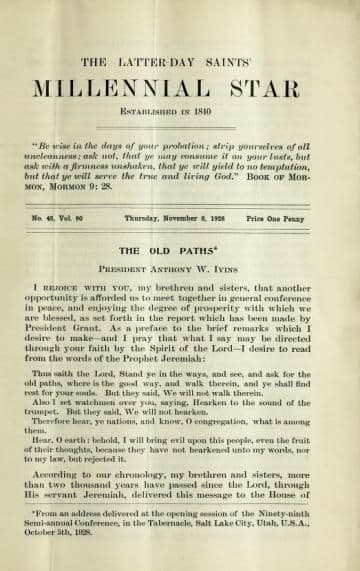Magazine
Scholarship and the Book of Mormon

Title
Scholarship and the Book of Mormon
Magazine
The Latter Day Saints' Millennial Star
Publication Type
Magazine Article
Year of Publication
1928
Authors
Widtsoe, John A. (Primary)
Pagination
712–713
Date Published
8 November 1928
Volume
90
Issue Number
45
Abstract
Widtsoe asserts that, although scientific research may substantiate items discussed in the Book of Mormon, there is no need for a scientific explanation for the book.
EDITORIAL
SCHOLARSHIP AND THE BOOK OF MORMON
The Mayas, or Mayan race, according to modern scholarship, attained the highest civilization in ancient America. They flourished in a region from Northern Guatemala to Yucatan in Central America, and have left behind them “great and numerous ruins of stone and mortar,” many hundreds of ruins, in fact. The history of the Mayas, as deciphered from inscriptions on the ruins, goes back to about 600 B.C. Students agree that the Mayas gradually moved northward “during the fourth and fifth centuries of the Christian era” and abandoned “the previously occupied capitals to the south”; and “by 630 A.D. everyone of the great cities had been abondoned.” Scholars have not been able to account satisfactorily for this northward movement, nor for the practical extinction of this ancient American people. Nevertheless the general facts are as commonplaces among those who study the subject, as shown by the current literature. In the September 21st issue of the authoritative magazine Science, Professor L.G. Huntley, expert in this subject, declares that a few broad facts, such as the above, upon which all are agreed, have resulted from the careful work of the past two decades; and in the October number of the Geographical Review, Professor H.J. Spinden, also an authority in American archaeology, presents diagrams and maps and makes statements to the same effect.
Such conclusions are of especial interest to the Latter-day Saints. The Book of Mormon is chiefly a record of the descendants of one Lehi, who came out of Jerusalem about 600 B.C., and whose descendants increased to be several numerous peoples. They moved northward, and towards the middle of the fifth century after Christ, the most enlightened and advanced branch, the Nephites, was largely destroyed by continuous and bloody warfare. The Book of Mormon also gives briefer accounts of other inhabitants of ancient America, some of whom reached the New World centuries before Lehi, and others about the same time. The history of the ancient Americans, of whom the North and South American Indians are the descendants, would be long and interesting were it fully known.
When the Book of Mormon, translated “by the gift and power of God”, was published in 1830, little was known about ancient America, and the story of former higher civilizations on the American continent was held to be the product of wild imagination. To-day, the Book of Mormon account is largely confirmed by our new knowledge.
Latter-day Saints make no attempt to identify any of the Book of Mormon peoples with those set up by students as a result of scientific explanation. There is no need to do so, for every step onward adds confirmation to the general truth of the Book of Mormon record.
The Book of Mormon is a repository of sacred truth for the guidance of man in his search for happiness; and it also contains a sound and truthful history of the ancient peoples from whose lives and acts the moral teachings of the book are drawn.—W.
Subject Keywords
Bibliographic Citation
Terms of use
Items in the BMC Archive are made publicly available for non-commercial, private use. Inclusion within the BMC Archive does not imply endorsement. Items do not represent the official views of The Church of Jesus Christ of Latter-day Saints or of Book of Mormon Central.